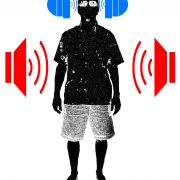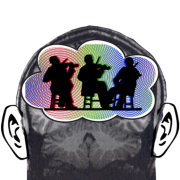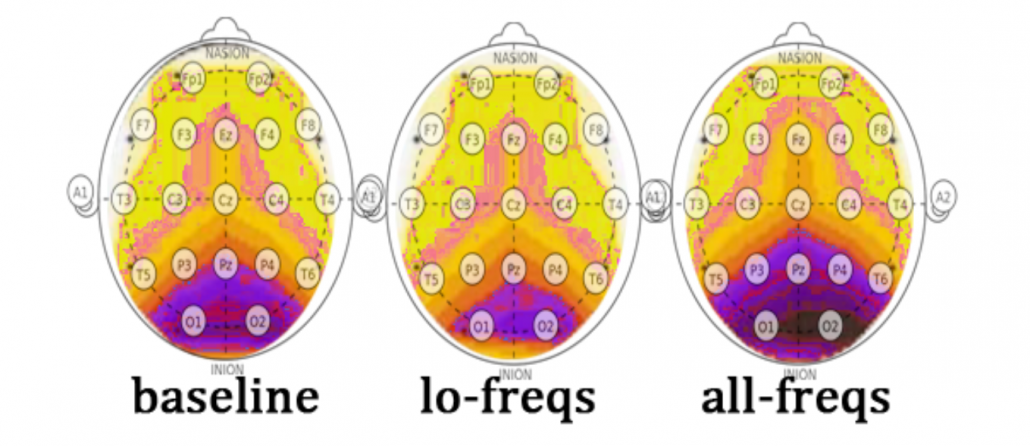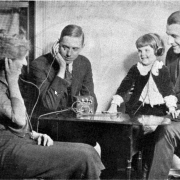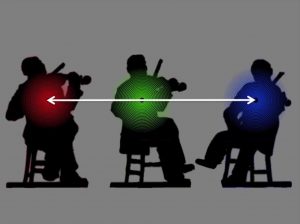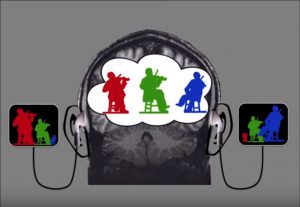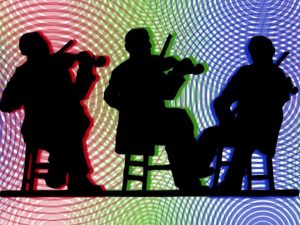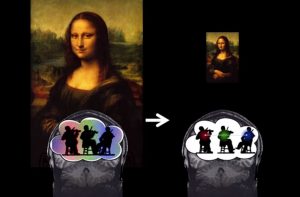Dr. Roger Dumas – Your Brain Hears More Than You Think Blog
Abbrevi-ossary
20k – 20kHz – 20 kiloHertz audio frequency – 20,000 cycles/second (the scientifically-accepted upper limit of human hearing)
Alpha-EEG – neuron populations firing at frequencies between 7.5Hz and 12.5Hz
CLL – comfortable listening level
EEG – electroencephalograpy
FRS – full range sound (HFC + LFC)
HFC – high-frequency component (above 22kHz)
IRB – institutional review board
LFC – low-frequency component (below 22kHz)
~~~~~
Previously on YBHMTYT (Your Brain Hears More Than You Think), you were presented with evidence that humans respond to sound waves at frequencies up to 50k Hz. According to researchers at ATR:
from ‘Inaudible high-frequency sounds affect brain activity: hypersonic effect.’
“Although it is generally accepted that humans cannot perceive sounds in the frequency range above 20 kHz, the question of whether the existence of such ‘inaudible’ high-frequency components may affect the acoustic perception of audible sounds remains unanswered. In this study, we used noninvasive physiological measurements of brain responses to provide evidence that sounds containing high-frequency components (HFCs) above the audible range significantly affect the brain activity of listeners.
“Psychological evaluation indicated that the subjects felt the sound containing an HFC to be more pleasant than the same sound lacking an HFC. These results suggest the existence of a previously unrecognized response to complex sound containing particular types of high frequencies above the audible range. We term this phenomenon the “hypersonic effect.” (Oohashi 2000)
That last bit intrigues. If you were one of ATR’s business partners and you got the good news that people turn music up when it’s hypersonic, wouldn’t you pony-up for another neuroscience study? You bet you would. In 2006, the research team was given a green light to take the hypersonic effect to the next level. Their experiment design discussion might have played out like this:
Principal Investigator: “Okay. We know that people respond to above-20k music.”
Grad Student: “They not only respond, they appreciate it more. We know this because they’ll turn up the volume for hypersonic music.”
Post-Doc: “Also, we’ve seen a significant difference in alpha-EEG signal (7.5-12.5 Hz) for brains exposed to hypersonic music as compared to silence or standard music. That means the effect is real.”
PI: “But since the human auditory system seems to have adapted to use only frequencies under 20k, how are people getting hypersonic information?”
GS: “Gotta be biological.”
PD: (snickers) “Uh, yeah. That’s like, from the Journal of DUH.”
PI: “Now, now, GS has a point. How can we test it.”
PD: “Well, I suppose we could take ears out of the equation, like make the subjects temporarily deaf or something.”
PI: “I’ll never get that past the IRB. Not even gonna try.”
GS: “But couldn’t we isolate the ears from the rest of the body somehow? Give two presentations, ears only or full body for hypersonic or regular music.”
PD: “Yeah, and we could cover-up the body for some of the trials.
PI: “Now you’re talking! We’ll split the high and low components like we did before, but we’ll play them through speakers and/or earphones with the body exposed or covered. We’ll run ‘em through the EEG and behavioral task. Let’s do it!”
Which leads us to today’s review. Please note – all images in this article were fabricated by the author from freely-available resources. No copyright holders were harmed.
~~~~~
Biological Mechanism of Perception of Inaudible High-frequency Component Included in Music Sounds, Oohashi T., Nishina E., Kawai N., Honda M., Yagi R., Morimoto M., Nakamura S., Maekawa T., Yonekura Y., Shibasaki H., The third International Symposium on Traditional Polyphony. (Tbilisi, Georgia, Sep. 2006)
Abstract
“We showed that sounds of various traditional polyphony including Kartuli Pholyphonia and various ethnic musical instruments contain inaudible high-frequency component of air vibration above human audible range with conspicuous, non-stationary fluctuation in a micro temporal domain of the order of millisecond. Using a cutting-edge scientific approach, we discovered that inaudible high-frequency components with complex structure activate the reward-generating neuronal system in the brain and make the musical sounds more comfortable to hear. We have called these phenomena collectively “the hypersonic effect.” It remains unclear, however, how such inaudible high-frequency components are transduced and perceived by listeners. We have recently succeeded in showing that inaudible high-frequency components of air vibration are perceived via some unknown sensing mechanism situated on the body surface, not via conventional air-conducting auditory system through ears. In this paper, we report the detail of this finding.” (Oohashi 2006)
Methods
Neuroimaging. Human brain activity was measured with electroencephalography (EEG) across 12 scalp sites during exposure to a super-audio CD (SACD) recording of Gambang Kuta, an Indonesian folk tune performed by the internationally-known gamelan orchestra Gunung Jati. (This is the same stimulus used in Oohashi 2000.)
Behavioral measurements. Subjects also engaged in a behavioral task during each trial, which was to adjust the music loudness to a comfortable listening level (CLL) using an up-down switch to operate a motorized fader between the SACD player and a pre-amp.
Stimulus. Capturing and playing hypersonic music is easy, especially if you own a proprietary high-speed one-bit coding signal processor with an A/D sampling frequency of 3.072 MHz like the Authentic Signal Disc ARHS9002 and Authentic Hypersonic Sound System (Yagi et al, 2002). As before, the signal was split into two bands, everything <22k and everything >22k (Fig. 1).
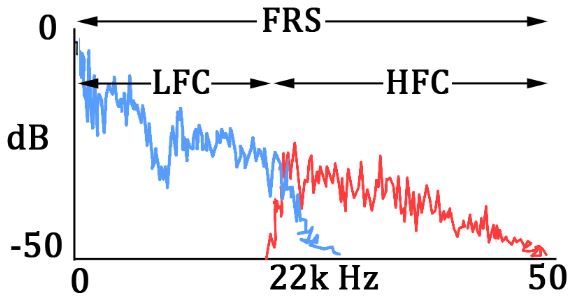
Figure 1. Frequency/amplitude chart for hypothetical hypersonic music sample split at 22k Hz. FRS, full-range sound; LFC, low-frequency component (blue waveform); HFC, high-frequency component (red waveform).
Conditions. Now that they had the signal split, investigators could present three different stimuli (FRS, LFC and HFC) under three conditions (earphones, speakers with subject’s body exposed, speakers with body covered). The subsequent four sub-experiments chosen are explained in Table 1 and Figure 2.
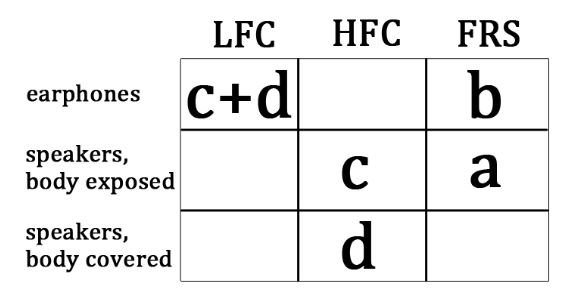
Table 1. Table of 3 stimuli and 3 presentation conditions. For each treatment, LFC and HFC were played either alone or together during different trials.


Figure 2. Four treatments. (a) Both LFC and HFC presented through speakers; (b) Both LFC and HFC presented through earphones; (c) LFC presented through earphones, HFC presented through speakers; (d) LFC presented through earphones, HFC presented through speakers but with sound insulators preventing exposure of the subject’s head and body surface to HFC.
Results
Neuroimaging. Alpha-EEG was significantly greater for FRS (as compared to LFC alone) when HFC was played over speakers (Fig 3a and 3c). When the subjects’ bodies were covered, alpha-EEG power was significantly diminished (Fig. 3d).
Behavioral. Measurements of subject behavior paralleled EEG results. Subjects usually adjusted loudness to significantly higher CLLs during FRS when HFC was played over speakers (Fig 3a and 3c). Conversely, subjects set CLLs at similar levels when during FRS when HFC was played through earphones. When a body surface was insulated from HFC coming through speakers, CLL was much lower.

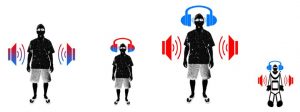
Figure 3. EEG results across four treatments (LFC and HFC played simultaneously). a) FRS over speakers, b) FRS through earphones, c) LFC-earphones/HFC-speakers, body exposed, d) LFC-earphones/HFC-speakers, body covered. Subject images scaled to reflect overall alpha-EEG power levels.
Take-home message
The hypersonic effect is real, but it only works over speakers. And although this study shows that listeners tend to crank it up when hearing hypersonic music, subsequent research established that listeners could hear no qualitative difference between enhanced SACD and standard CD formats at normal listening levels. That finding might have dampened enthusiasm for marketing hi-res music to a general audience, but one can still purchase SACD players and find tons of great music on SACD.
And anyway, as Duke Ellington tells us, “If it sounds good, it is good.” You like it? Play it.
Next time, let’s talk about how your brain lives in the past.
�
~~~~~
Bibliography
Oohashi, T., et al. (2000). Inaudible high-frequency sounds affect brain activity: hyper-sonic effect. J. Neurophysiol, 83:3548-3558.
Oohashi T., Nishina E., KAWAI N., Honda M., Yagi R., Morimoto M., Nakamura S., Maekawa T., Yonekura Y., Shibasaki H., Biological Mechanism of Perception of Inaudible High-frequency Component Included in Music Sounds, The third International Symposium on Traditional Polyphony. (Tbilisi, Georgia, Sep. 2006)
Yagi, R., et all. (2002) Auditory Display for Deep Brain Activation: Hypersonic Effect. In: The 8th International Conference on Auditory Display . (pp.248-253).


